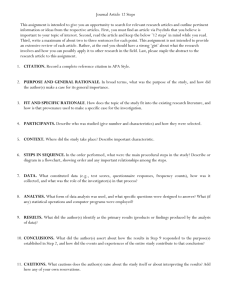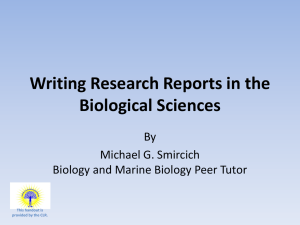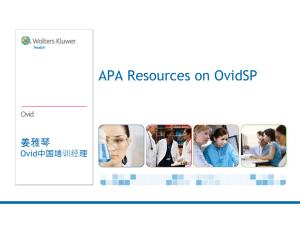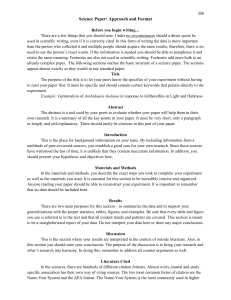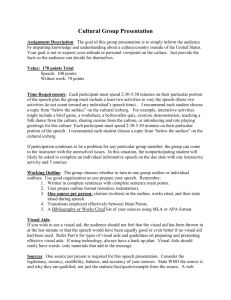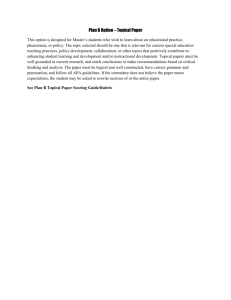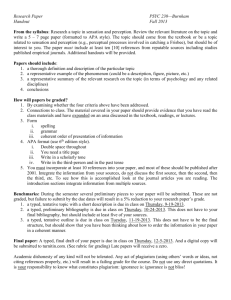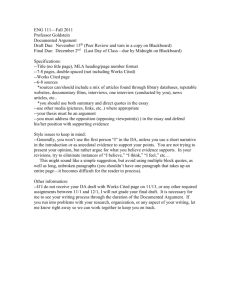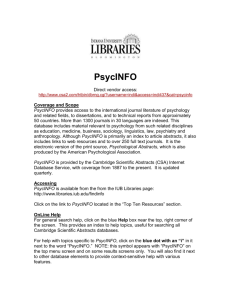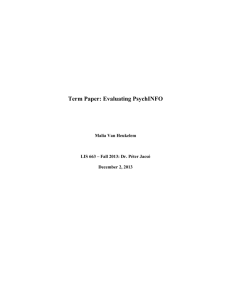Laboratory Assignment #2
advertisement
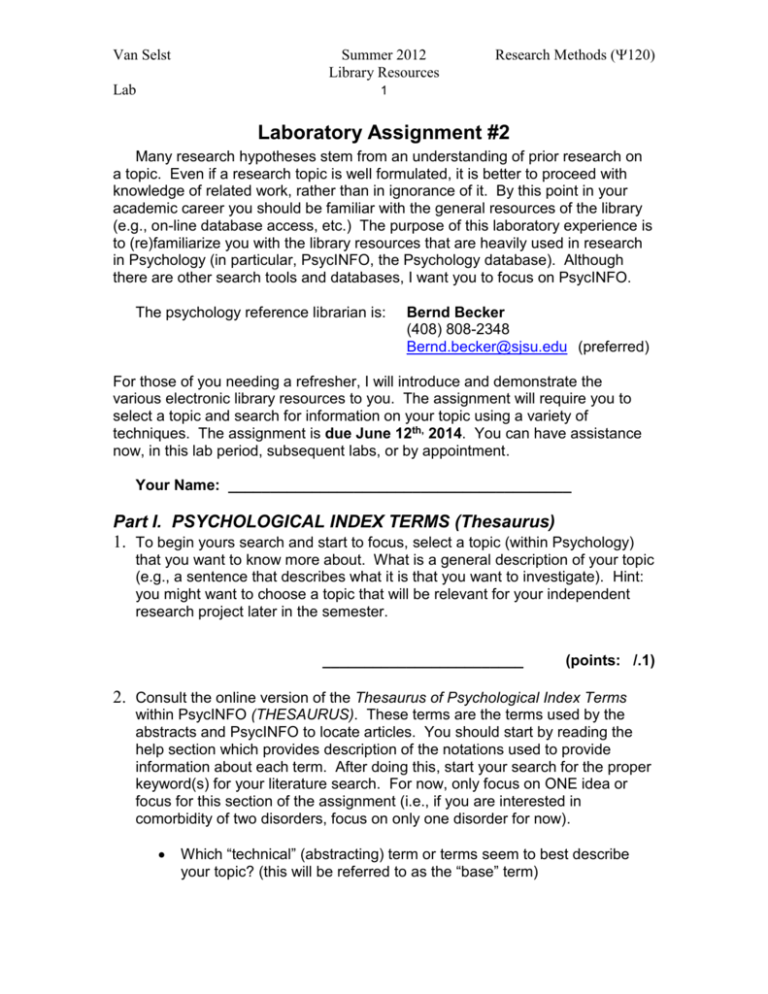
Van Selst Lab Summer 2012 Library Resources Research Methods (120) 1 Laboratory Assignment #2 Many research hypotheses stem from an understanding of prior research on a topic. Even if a research topic is well formulated, it is better to proceed with knowledge of related work, rather than in ignorance of it. By this point in your academic career you should be familiar with the general resources of the library (e.g., on-line database access, etc.) The purpose of this laboratory experience is to (re)familiarize you with the library resources that are heavily used in research in Psychology (in particular, PsycINFO, the Psychology database). Although there are other search tools and databases, I want you to focus on PsycINFO. The psychology reference librarian is: Bernd Becker (408) 808-2348 Bernd.becker@sjsu.edu (preferred) For those of you needing a refresher, I will introduce and demonstrate the various electronic library resources to you. The assignment will require you to select a topic and search for information on your topic using a variety of techniques. The assignment is due June 12th, 2014. You can have assistance now, in this lab period, subsequent labs, or by appointment. Your Name: _________________________________________ Part I. PSYCHOLOGICAL INDEX TERMS (Thesaurus) 1. To begin yours search and start to focus, select a topic (within Psychology) that you want to know more about. What is a general description of your topic (e.g., a sentence that describes what it is that you want to investigate). Hint: you might want to choose a topic that will be relevant for your independent research project later in the semester. ________________________ (points: /.1) 2. Consult the online version of the Thesaurus of Psychological Index Terms within PsycINFO (THESAURUS). These terms are the terms used by the abstracts and PsycINFO to locate articles. You should start by reading the help section which provides description of the notations used to provide information about each term. After doing this, start your search for the proper keyword(s) for your literature search. For now, only focus on ONE idea or focus for this section of the assignment (i.e., if you are interested in comorbidity of two disorders, focus on only one disorder for now). Which “technical” (abstracting) term or terms seem to best describe your topic? (this will be referred to as the “base” term) Van Selst Summer 2012 Library Resources Lab Research Methods (120) 2 ________________________ (points: /.1) 3. Consult the thesaurus for your term. The “scope note” or “posting note” defines the term you are searching or provides additional context. [note: if the term does not have a scope note (or broader term, etc.) just write “N/A”]. a) Is there a scope note for (at least one of) your term(s)? write out (or copy) the scope note (if there is one) here: b) Is there a historic note? Copy it here. c) Any other notes? Copy it here. d) list one broader term (if present) (__________________) e) list one narrower term (if present) (__________________) f) list one related term (if present) (__________________) g) what year was your principal term first used / introduced (__________________) (points: /.3) 4. You may now (or after your initial Psycinfo search) wish to alter the topic of your search to one of the other terms listed or to include two or more terms in your search to better constrain/identify articles of interest. Within PsyINFO you can also “search by related term” and/or “search by relevance”. If this yields a better result, change your terms. What term(s) have you chosen to settle on for your search? When were they first used? a) Term: ________________ Year: ___________ b) Term: ________________ Year: ___________ (points: /.1) Van Selst Summer 2012 Library Resources Lab Research Methods (120) 3 Part II. PSYCINFO For Part II of your assignment, you will be using the PsycINFO computerized database search tool. Note that SJSU does have access to other computerized databases (e.g., Infotrac Web1 and Lexis-Nexis, Medline, Google Scholar), even though we will not be using them for this assignment. The other databases tend (as a whole) not to be as scholarly (e.g., include magazine articles) and/or are not as focused on psychology (although some share the useful option to allow researchers to limit the search to only peer reviewed articles). To do Part II, you will need to do a search of the PsycINFO database. The articles can be indexed by the name of the author, the topic of inquiry (from the Thesaurus), or other means. You should be able to find additional related articles in the reference sections of the articles that you have identified as relevant (from previewing their abstracts). 5. At the current time, what is the first year of publication that PsycINFO covers? (examine the “choose databases” section of PsycINFO for journal coverage date) ___________ [what year?] (points: /.10) 6. Search PsycInfo using your term(s) from Part I question 4. Be sure to restrict your (advanced) search to only Peer-Reviewed Journal Articles (i.e., DT=journal-article will be part of your search constraints). a) How many articles did you find? (points: /.10) 7. Do you want to further limit, expand, or change your search? (as a “cheating” move it is often useful to look at the keywords from the references that appear to be the most relevant) If you narrowed the list down, how many references are in the (new) narrowed list? (also note earlier comment about search for related terms or relevant articles) ○ yes if yes, new number: ________ if yes, how did you limit search? ○ no (points: /.10) 1 Formerly called Expanded Academic ASAP, this database provides indexing and abstracting to approximately 1500 scholarly and general interest periodicals from 1980 to the present. It covers all major fields of undergraduate study in the humanities, social sciences, and sciences /technology. It also indexes the last six months of the New York Times. The full text of many, but not all, articles is included Van Selst Lab Summer 2012 Library Resources Research Methods (120) 4 8. As you go through the references, print (or copy out) the references to at least three of the articles that look like they might be particularly relevant to you. Print (or email to yourself then print) the Abstract for one of these references (within PsycInfo you will have to select the desired options). (points /.20) is the (hardcopy/printed) abstract attached? ○ yes ○ no 9. Write out the three references in APA format (check the APA manual 7.01 #1, #3). For this question, complete the references as if you had the original, hardcopy from the original journal article in front of you. Note that your research methods text is not as reliable guide a guide to APA formatting as the APA manual and APA online updates. Include the digital object identifier (doi) if it is provided. (points /.30) [1] [2] [3] 10. Select one of the authors from question 9. Use PsycInfo to find other articles written by this person. How many references did you find for this author? Number =___________ (points /.10) 11. Write-out the APA-style reference to another article (not used in Question 9) written by the same author as Question 10 or another author from Question 9. Unlike Question 1, format this reference as to describe the abstract of the article as retrieved by PsycInfo (Publication Manual of the APA, 6th edition format 7.01 #16 [abstract online or abstract hardcopy]). (points /.20) 12. Write-out the APA-style reference for any article (previously identified in this assignment if possible) that you can find using the “GET TEXT” link from the PsycINFO search (use APA 6th edition format). For this particular example, you will NOT need to cite the web page since you will have a doi. This will be from a “Primary Source” rather than as a “Secondary Source” Van Selst Lab Summer 2012 Library Resources Research Methods (120) 5 (points /.10) PART III: Using “Times Cited in this Database” from PsycINFO The current task is for you to determine if any articles make reference to one of the articles you wrote a reference for earlier (ideally one from your psychological index text search). To do so you will use PsycINFO with “times cited in this database.” At this time, there is a bug in PsycINFO that drops the times cited down to zero when you save a reference into your folder and retrieve it later… so for each of these article searches, make sure you are using a “fresh” search rather than returning to an older connection (hopefully this will get fixed for the future). There are, in fact, many articles that are never cited – but know that each of the articles for VAN SELST have been cited at least once... 13. What is the sum number of articles that PsycINFO reports as having been authored or co-authored by me (Mark Van Selst, your instructor): _____________. Across all of these articles, what is the TOTAL number of OTHER articles that have cited these articles? _____________. (note: I only publish in psychology journals – it is ok to restrict to “peer reviewed journals only” if you choose – sum the “times cited in this database” numbers) (points /.30) 14. The next question is whether or the first article from question 9 (#1) has ever been cited (look for “times cited in this database”) under results link. Indicate the number of times cited. It is possible that it may have never been cited. (points /.20) 15. What is the sum number of times “cited in this database” for any one of the authors from any of your earlier searches (e.g., from question 8, 9, 10 but Not Q13). Keep searching if #14 was zero and your first try at #15 is zero. person: _________ number of citations: ___ (or just say >20 if true) (points /.20) 16. If your original article (question 9 (#1)) was cited (question 14 not zero), provide one APA style reference to the article that cited your original article. …If it was not cited, use one of the articles that cited your author from #15. Provide one APA style reference to the (more recent) article that cited the original (older) article. I am looking for the standard reference format “as if” you had the paper version (if hardcopy available) in front of you (i.e., do not cite the abstract, the web location, or anything else… just the regular plain vanilla citation [with doi if present]). (points /.20) Van Selst Summer 2012 Library Resources Lab Research Methods (120) 6 PART V: Citing a web-page 17. Write out the APA style reference to this assignment as posted on the course website. (points: /.1) PART VI: Finding an Article 18. Select any EMPIRICAL article (i.e., Experimental or Correlational rather than review, summary, etc.) of interest from any of the previous searches you performed. Use “Get Text” or other aspect of the library information technology system to determine that the journal exists at SJSU or is available electronically — for the library search function select “by title” and enter the name of the journal. Hit the “enter” key. You could find the Journal by going to the reference number that the system provides to you. Once you have found the full text of an article, print it out (or photocopy the hardcopy article) and identify some facts about the article. a. Is article attached? (at least first and last page) ○ yes ○ no (points: /.3) b. What is the title? (points: /.1) c. What is the hypothesis (purpose/basic question/…) that was investigated in the article? (points: /.2) d. Who were the participants? (points: /.1) e. Describe (one of) the dependent variable(s) and (one of) the Independent variable(s) [or predictor and outcome variable]. Independent variable = Dependent variable = —or— (if quasi-experimental or correlational) Predictor variable = Outcome variable = (points: /.2) f. Name (one or more) result that bears on the hypothesis? (points: /.2) Van Selst Summer 2012 Library Resources Lab Research Methods (120) 7 19. For another of the abstracts (from any one of the earlier computerized or physical searches), identify some facts about the article from the abstract (only if possible – if the information is not present answer “information not present”). a) Is article attached? (at least first and last page and including abstract) ○ yes ○ no (points: /.20) b) What is the title? (points: /.10) c) What is the hypothesis (purpose/basic question/…) that was investigated? (points: /.20) d) Who were the participants? (points: /.10) e) Describe (one of) the dependent variable(s) and (one of) the (points: /.30) Independent variable = Dependent variable = —or— (if quasi-experimental or Correlational) Predictor variable = Outcome variable = f) Name (one or more) result that bears on the hypothesis? (points: /.20) Note: it is ok to print this assignment. However, our experience indicates that people make more errors in italicization, capitalization (check the APA examples very carefully), and punctuation (e.g., period after journal name) with printed text than when done on a computer. To easily answer the questions… just write 1(a) and then the answer, etc. you do not need to retype the whole assignment complete with instructions, etc.
